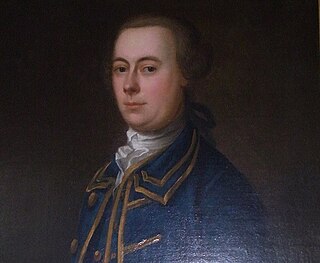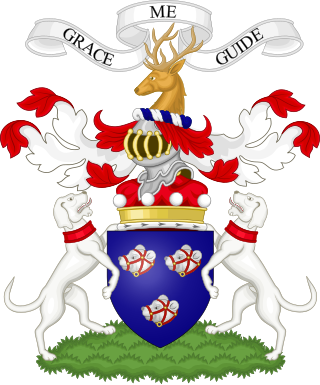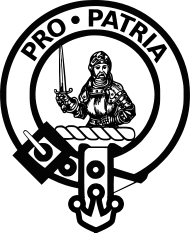
Marquess of Aberdeen and Temair, in the County of Aberdeen, in the County of Meath and in the County of Argyll, is a title in the Peerage of the United Kingdom. It was created on 4 January 1916 for John Hamilton-Gordon, 7th Earl of Aberdeen.

Clan Agnew is a Scottish clan from Galloway in the Scottish Lowlands.

Clan Gordon is a Highland Scottish clan, historically one of the most powerful Scottish clans. The Gordon lands once spanned a large territory across the Highlands. Presently, Gordon is seated at Aboyne Castle, Aberdeenshire. The Chief of the clan is the Earl of Huntly, later the Marquess of Huntly.

Sir Harry Munro, 7th Baronet was 25th Baron and the 28th chief of the Clan Munro. He was a Scottish soldier and politician. He was loyal to the Hanoverian dynasty and served as a captain in Loudon's Highlanders Regiment 1745–48.

Clan Murray is a Highland Scottish clan. The chief of the Clan Murray holds the title of Duke of Atholl. Their ancestors were the Morays of Bothwell who established the family in Scotland in the 12th century. In the 16th century, descendants of the Morays of Bothwell, the Murrays of Tullibardine, secured the chiefship of the clan and were created Earls of Tullibardine in 1606. The first Earl of Tullibardine married the heiress to the Stewart earldom of Atholl and Atholl therefore became a Murray earldom in 1626. The Murray Earl of Atholl was created Marquess of Atholl in 1676 and in 1703 it became a dukedom. The marquess of Tullibardine title has continued as a subsidiary title, being bestowed on elder sons of the chief until they succeed him as Duke of Atholl.

Clan Menzies ; Scottish Gaelic: Clann Mèinnear; a member is a Mèinnearach) is a Highland Scottish clan.
William Gordon, 2nd Earl of Aberdeen, known between c. 1691 and 1720 as Lord Haddo, was a Scottish landowner and Tory politician who sat in the British House of Commons briefly from 1708 to 1709 when he was declared ineligible, being the eldest son of a Scottish peer. He showed some Jacobite sympathies, but took no part in the rebellions.

Clan Drummond is a Highland Scottish clan. The surname is rendered "Druimeanach" in modern Scottish Gaelic.

Clan Carnegie is a Lowland Scottish clan.

Clan Cochrane is a Scottish clan of the Scottish Lowlands.

Clan Ogilvy, also known as Clan Ogilvie, is a Highland Scottish clan. Originating from Angus, Scotland, the progenitor of the Clan received a barony from King William the Lion in 1163. In 1491, King James IV elevated Sir James Ogilvy as Lord Ogilvy of Airlie.

Clan Rattray is a Highland Scottish clan.
The Bannerman Baronetcy, of Elsick in the County of Kincardine, is a title in the Baronetage of Nova Scotia. It was created on 28 December 1682 for Alexander Bannerman. The eleventh Baronet was a pioneer military aviator. The twelfth Baronet was a soldier and courtier.
Sir John Gordon, 1st Baronet was a Scottish Royalist supporter of Charles I during the Wars of the Three Kingdoms. Gordon distinguished himself against the covenanters at Turriff, 1639, and joined Charles I in England. Created a baronet in 1642 for his services, he was excommunicated and forced to surrender by the Covenanters under Argyll at Kellie in 1644 and was subsequently beheaded for treason at Edinburgh.

Clan Forbes is a Highland Scottish clan from Aberdeenshire, Scotland.

Clan Munro is a Highland Scottish clan. Historically the clan was based in Easter Ross in the Scottish Highlands. Traditional origins of the clan give its founder as Donald Munro who came from the north of Ireland and settled in Scotland in the eleventh century, though its true founder may have lived much later. It is also a strong tradition that the Munro chiefs supported Robert the Bruce during the Wars of Scottish Independence. The first proven clan chief on record however is Robert de Munro who died in 1369; his father is mentioned but not named in a number of charters. The clan chiefs originally held land principally at Findon on the Black Isle but exchanged it in 1350 for Estirfowlys. Robert's son Hugh who died in 1425 was the first of the family to be styled "of Foulis", despite which clan genealogies describe him as 9th baron.
Clan Paterson is a Lowland Scottish clan. The clan is officially recognized as such by the Lord Lyon King of Arms; however, as the clan does not currently have a chief it is considered an Armigerous clan.
Sir Alexander Bannerman, 6th Baronet was a Scottish medical doctor and professor of medicine at the University of Aberdeen.
Sir Alexander Bannerman, 9th Baronet was a Scottish diplomat.

Alexander Robertson of Struan, 13th Chief of Clan Robertson, was a Scottish Jacobite soldier and poet, notable for being the only person recorded to have participated in three Jacobite risings.















